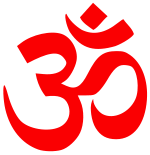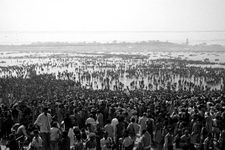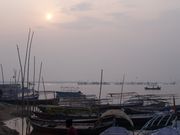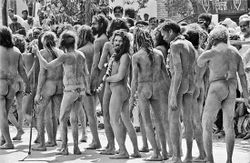Kumbh Mela
|
An article related to |
|---|
 Auṃ • Brahman • Ishvara |
|
Scriptures
|
|
Practices
|
|
Philosophers
|
|
Other Topics
|
|
Hinduism Portal |
| Kumbh Mela | |
|---|---|
 2001 Kumbh Mela at Allahabad |
|
| Official name | Kumbh Mela |
| Observed by | Hindus |
| Type | Hinduism |
| Begins | Pausa Purnima |
| Ends | Magha Purnima |

Kumbh Mela (Devanagari: कुम्भ मेला) is a mass Hindu pilgrimage.
The Kumbh Mela is celebrated every 4 years, the Ardh (half) Kumbh Mella is celebrated every six years at Haridwar and Prayag [1], the Purna (complete) Kumbh takes place every twelve years,[2] at four places (Prayag (Allahabad), Haridwar, Ujjain, and Nashik). The Maha (great) Kumbh Mela which comes after 12 'Purna Kumbh Melas', or 144 years, is held at Allahabad.[2][3][4]
The last Ardh Kumbh Mela was held over a period of 45 days beginning in January 2007, more than 17 million Hindu pilgrims took part in the Ardh Kumbh Mela at Prayag, and on January 15, the most auspicious day of the festival of Makar Sankranti, more than 5 million participated.[5]
The last Maha Kumbh Mela, held in 2001, was attended by around 60 million people, making it the largest gathering anywhere in the world in recorded history.[6][7][8][9]
Contents |
Timing
Kumbha Mela is a massive pilgrimage in which Hindus gather at the Ganges river. It is celebrated at different locations depending on the position of the planet of Bṛhaspati (Jupiter) and the sun. When Jupiter and the sun are in the zodiac sign Leo (Simha Rashi) it is held in Trimbakeshwar, Nashik; when the sun is in Aries (Mesha Rashi) it is celebrated at Haradwar; when Jupiter is in Taurus (Vrishabha Rashi ) and the sun is in Capricorn (Makar Rashi) Kumbha Mela is celebrated at Prayag; and Jupiter and the sun are in Scorpio (Vrishchik Rashi) the Mela is celebrated at Ujjain.[10][11] Each site's celebration dates are calculated in advance according to a special combination of zodiacal positions of Sun, Moon, and Jupiter.[12]
Etymology
Kumbha is a Sanskrit word for Pitcher (actually a roundish pot with no handles), sometimes referred to as the Kalasha. It is also a zodiac sign in Indian astrology for Aquarius, the sign under which the festival is celebrated, while Mela means 'a gathering' or 'a meet', or simply a fair.
History

The first written evidence of the Kumbha Mela can be found in the accounts of Chinese traveller, Huan Tsang or Xuanzang (602 - 664 A.D.) who visited India in 629 -645 CE, during the reign of King Harshavardhana.[13][14][15] However, the observance dates back many centuries to Ancient India's Vedic period, where the river festivals first started getting organised. In Hindu mythology, its origin is found in one of the popular creation myths and the Hindu theories on evolution, the Samudra manthan episode (Churning of the ocean of milk), mentioned in the Bhagavata Purana, Vishnu Purana, the Mahabharata, and the Ramayana.[16]
The account goes that the Gods had lost their strength, and to regain it, they thought of churning the Ksheera Sagara (primordial ocean of milk) for amritha (the nectar of immortality). This required them to make a temporary agreement with their arch enemies, the demons or Asuras, to work together with a promise of sharing the nectar equally thereafter.[17] However, when the Kumbha (urn) containing the amrita appeared, a fight ensued. For twelve days and twelve nights (equivalent to twelve human years) the gods and demons fought in the sky for the pot of amrita. It is believed that during the battle, Lord Vishnu flew away with the Kumbha of elixir spilling drops of amrita at four places: Prayag, Haridwar, Ujjain and Nashik.[18]
Attendance
According to The Imperial Gazetteer of India, an outbreak of cholera occurred at the 1892 Mela at Haridwar leading to the rapid improvement of arrangements by the authorities and to the formation of Haridwar Improvement Society. In 1903 about 400,000 people are recorded as attending the fair.[11] During the 1954 Kumbh Mela stampede at Allahabad, around 500 people were killed, and scores were injured. Ten million people gathered at Haridwar for the Kumbh on April 14, 1998.[13]
The 1998 Kumbh Mela saw over 10 million pilgrims visiting Hardwar, to take a dip in the holy Ganga river.[19] In 2001, around 1 million people from outside of India and from around the world participated in the Maha Kumbh Mela at Prayag (Allahabad), with a total participation of approximately 60 million. This mela was unusually significant due to the planetary positions at the time, a pattern that repeats only once every 144 years.[20]
The Ritual

The major event of the festival is ritual bathing at the banks of the river in whichever town it is being held. Other activities include religious discussions, devotional singing, mass feeding of holy men and women and the poor, and religious assemblies where doctrines are debated and standardized. Kumbh Mela is the most sacred of all the pilgrimages. Thousands of holy men and women attend, and the auspiciousness of the festival is in part attributable to this. The sadhus are seen clad in saffron sheets with ashes and powder dabbed on their skin per the requirements of ancient traditions. Some, called naga sanyasis, may not wear any clothes even in severe winter.
After visiting the Kumbh Mela of 1895, Mark Twain wrote:
| “ | It is wonderful, the power of a faith like that, that can make multitudes upon multitudes of the old and weak and the young and frail enter without hesitation or complaint upon such incredible journeys and endure the resultant miseries without repining. It is done in love, or it is done in fear; I do not know which it is. No matter what the impulse is, the act born of it is beyond imagination, marvelous to our kind of people, the cold whites.[21] | ” |
Recent Kumbh Melas
1894
According to Paramahansa Yogananda in his work the Autobiography of a Yogi, it was on the Kumbha Mela in January 1894 at Prayag that his Guru Sri Yukteswar met Mahavatar Babaji for the first time.[22].
2001
In 2001, Kumbhmela was held in Prayag. It is estimated that about 60 million people took a bath in the river Ganges on the occasion.
2003
When the Kumbh Mela was held in Nashik, India, from July 27 to September 7, 2003, 39 pilgrims (28 women and 11 men) were trampled to death and 57 were injured. Devotees had gathered on the banks of the Godavari river for the maha snaan or holy bath. Over 30,000 pilgrims were being held back by barricades in a narrow street leading to the Ramkund, a holy spot, so the sadhus could take the first ceremonial bath. Reportedly, a sadhu threw some silver coins into the crowd and the subsequent scramble led to the stampede.[23][24]
2007
Every six years there is an Ardh Kumbh Mela at Prayag (also known as Allahabad).
2010
Haridwar is hosting the Purna Kumbha mela from Makar Sankranti (14 January 2010) to Shakh Purnima Snan (28 April 2010). Millions of Hindu pilgrims attended the mela. On April 14, 2010 alone approximately 10 million people bathed in the Ganges river.[25] According to officials by mid April about 40 million people had bathed since January 14, 2010.[26] Hundreds of foreigners joined Indian pilgrims in the festival which is thought to be the largest religious gathering the world.[26][27] To accommodate the large number of pilgrims Indian Railways ran special trains.[28] At least 5 people died in a stampede after clashes between holy men and devotees.[29]
Indian Space Research Organisation took satellite pictures of the crowds with the hope of improving the conduct of the festival in the future.[30]
Future Venues
- The Purna Kumbha Mela will again be held at Prayag in the year 2013 (January 27 to February 25)
- Nasik will host the Ardha Kumbha Mela in 2015 (August 15 to September 13)
- Ujjan Purna Kumbh Mela 2016 (Also Known as Simhasth @ Ujjain) (April 22 to May 21)
Kumbh Mela in Media
Amrita Kumbher Sandhane, a 1982 Bengali feature film directed by Dilip Roy, documents the Kumbh Mela. Kumbha Mela has been theme for many a documentaries, including "Kumbh Mela: The Greatest Show on Earth" (2001) by [31], (2004), by Maurizio Benazzo and Nick Day [32][33], Kumbh Mela: Songs of the River (2004), by Nadeem Uddin[34], and Invocation, Kumbha Mela (2008) [35]
Bollywood movies often jokingly refer to Kumbh Mela as a place where the character lost his/her twin brother/sister. The most common script line being in Hindi "Hum bachpan me kumbh ke mele me kho gaye the". This is a common parody in recent times, being an effect of many movies using this lost-and-found device in the past.
On April 18, 2010, a popular American morning show The CBS Sunday Morning gave an extensive coverage on Haridwar's Kumbh Mela "The Largest Pilgrimage on Earth". Calling it "one of the most extraordinary displays of faith on Earth, a spectacular journey drawing tens of millions of people".
On April 28, 2010, BBC reported an audio and a video report on Kumbh Mela, titled "Kumbh Mela 'greatest show on earth'.
See also
- Mahamaham
- 1954 Kumbh Mela stampede
- Pushkaram
Further reading
- Kumbha Mela: History and Religion, Astronomy and Cosmobiology, by Subas Rai. Published by Ganga Kaveri Pub. House, 1993. ISBN 81-85694-01-X.
- The Kumbh Mela, by Mark Tully (Author), Richard Lannoy (Photographer), Ashok Mahendra (Photographer). Indica Books. 2002. ISBN 81-86569-22-7.
- Kumbha Mela, by Jack Hebner. Published by Transition Vendor, 2003. ISBN 1-886069-90-5.
- Nashik Kumbh Mela: A Spiritual Sojourn, by Govind Swarup. India Book House Ltd, 2006. ISBN 81-7508-379-4.
- Pilgrimage and Power: The Kumbh Mela in Allahabad, 1765-1954, by Kama Maclean. Oxford University Press, USA. 2008. ISBN 0-19-533894-4.
References
- ↑ The Urn Festival TIME, Feb 08, 1960.
- ↑ 2.0 2.1 Kumbh Mela The Basis of Civilization--water Science?: Water Science?, by J. C. Rodda, Lucio Ubertini, International Association of Hydrological Sciences, IAHS International Commission on Water Resources Systems, Consiglio nazionale delle ricerche (Italy). Published by International Association of Hydrological Science, 2004. ISBN 1-901502-57-0 Page 165.
- ↑ The Maha Kumbh Mela 2001 indianembassy.org.
- ↑ Kumbh Mela dates kumbhamela.net.
- ↑ Millions of Hindus Wash Away Their Sins Washington Post, January 15, 2007.
- ↑ Millions bathe at Hindu festival BBC News, January 3, 2007.
- ↑ Kumbh Mela pictured from space - probably the largest human gathering in history BBC News, January 26, 2001.
- ↑ Kumbh Mela: the largest pilgrimage - Pictures: Kumbh Mela by Karoki Lewis The Times, March 22, 2008.
- ↑ Kumbh Mela - 25 January 2001 - New Scientist
- ↑ Kumbha Mela Students' Britannica India, by Dale Hoiberg, Indu Ramchandani. Published by Popular Prakashan, 2000. ISBN 0-85229-760-2.Page 259-260.
- ↑ 11.0 11.1 Haridwar The Imperial Gazetteer of India, 1909, v. 13, p. 52.
- ↑ Kumbh Mela 'Britannica.com.
- ↑ 13.0 13.1 Kumbh Mela - Timeline What Is Hinduism?: Modern Adventures Into a Profound Global Faith, by Editors of Hinduism Today, Hinduism Today Magazine Editors. Published by Himalayan Academy Publications, 2007. ISBN 1-934145-00-9. 242-243.
- ↑ Kumbh Mela www.archaeologyonline.net.
- ↑ Kumbh Mela Channel 4.
- ↑ Ramayana, Book I; Canto: XLV - The Quest for the Amrit Ramayana of Valmiki.
- ↑ The Holiest Day in History TIME, Jan 31, 1977.
- ↑ Urn Festival TIME, May 1, 1950.
- ↑ "Kumbh Mela, a study". Missouri State University. http://courses.missouristate.edu/JLlewellyn/kumbhmela.html.
- ↑ "Maha Kumbh Mela concludes". The Hindu. http://www.hinduonnet.com/2001/02/22/stories/0222000p.htm.
- ↑ Mark Twain, "Following the Equator: A journey around the world"
- ↑ Autobiography of a Yogi by Paramahansa Yogananda Chapter 36 Autobiography of a Yogi by Paramahansa Yogananda, wikisource.
- ↑ 39 killed in Kumbh Mela stampede The Hindu, Aug 28, 2003
- ↑ Holy man's gift blamed for 39 dead in stampede The Guardian, August 28, 2003.
- ↑ Yardley, Jim; Kumar,Hari (2010-04-14). "Taking a Sacred Plunge, One Wave of Humanity at a Time". The New York Times. http://www.nytimes.com/2010/04/15/world/asia/15india.html. Retrieved 15 April 2010.
- ↑ 26.0 26.1 Millions dip in Ganges at world's biggest festival, Agence France-Presse, 2010-04-13
- ↑ Foreigners join huge crowds at India’s holy river festival, The Gazette (Montreal), 2010-04-14
- ↑ "More trains during Kumbh Mela". The Times of India. 2010-04-11. http://timesofindia.indiatimes.com/city/lucknow/More-trains-during-Kumbh-Mela/articleshow/5783377.cms. Retrieved 16 April 2010.
- ↑ Five die in stampede at Hindu bathing festival, BBC, 2010-04-14
- ↑ ISRO taking satellite pictures of Mahakumbh mela, Press Trust of India, 2010-04-13
- ↑ Kumbh Mela: The Greatest Show on Earth at the Internet Movie Database
- ↑ Short Cut to Nirvana at the Internet Movie Database
- ↑ Mela films
- ↑ Kumbh Mela: Songs of the River at the Internet Movie Database
- ↑ Invocation, Kumbha Mela at the Internet Movie Database
External links
- Official website of Kumbha mela 2010
- Kumbh Mela Haridwar
- Best of Kumbh Mela Photographs
- Comprehensive Research Article on the Kumbh Mela with Photographs
- World's Largest Act of Faith
- Video of 2010 Maha Kumbh Mela in Haridwar from Guardian.co.uk
|
||||||||||||||||